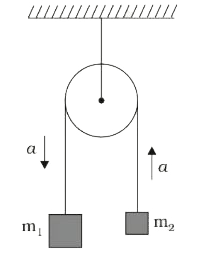Two bodies 1 and 2 of different shapes are released on the surface of a deep pond. The mass of the two bodies are m1=1kg and m2=1.2kg respectively. While moving through water, the bodies experience resistive force given as R=bv, where v is speed of the body and b is a positive constant dependent on shape of the body. For bodies 1 and 2 value of b is 2.5kg/s and 3.0kg/s respectively. Neglect all other forces apart from gravity and the resistive force, while answering following questions : [Hint : acceleration =force/mass]
(i) With what speed v10 and v20 will the two bodies hit the bed of the pond. [Take g=10m/s2]
(ii) Which body will acquire speed equal to half the terminal speed in less time.
The correct Answer is:(i) v10=v20=4m/s (ii) Both will take same time
Topper's Solved these Questions
- KINEMATICSBook:ARIHANTChapter:KINEMATICSExercise:Level 3
Explore 33 Videos
- KINEMATICSBook:ARIHANTChapter:KINEMATICSExercise:Level 3
Explore 33 Videos
- HEAT TRANSFERBook:ARIHANTChapter:HEAT TRANSFERExercise:Heat Transfer
Explore 45 Videos
- KINETIC THEORY OF GASESBook:ARIHANTChapter:KINETIC THEORY OF GASESExercise:Level 3
Explore 4 Videos
Similar Questions
Two bodies of masses m1andm2(<m1) are connected to the ends of a massless cord and allowed to move as shown in figure. The pulley is both massless and frictionless. The acceleration of the centre of mass is (m1−m2)n(m1+m2)2g. Find the value of n.

View SolutionTwo bodies of masses m1andm2(<m1) are connected to the ends of a massless cord and allowed to move as shown in figure. The pulley is both massless and frictionless. The acceleration of the centre of mass is (m1−m2)n(m1+m2)2g. Find the value of n.

View Solution
Knowledge Check
Two bodies of masses m1 and m2 are separated by a distance R. The distance of the centre of mass of the bodies from the mass m1 is
Am2Rm1+m2Bm1Rm1+m2Cm1m2m1+m2RDm1+m2m1RTwo bodies of masses m1 and m2 are separated by a distance R. The distance of the centre of mass of the bodies from the mass m1 is
Am2Rm1+m2Bm1Rm1+m2Cm1m2m1+m2RDm1+m2m1RTwo bodies of mass 2 kg and 5 kg have position (1 m, 2 m, 1 m) and (3 m, 2 m, -1 m) respectively. The position vector of centre of mass is
A(177ˆi+2ˆj−37ˆk)mB(17ˆi+14ˆj−3ˆk)mC(2ˆi+177ˆj−37ˆk)mD(14ˆi+17ˆj−3ˆk)m
Two bodies of masses 1 kg and 2 kg moving with same velocities are stopped by the same force. Then, the ratio of their stopping distances is
View SolutionTwo bodies A and B having masses 2 kg and 4 kg respectively are separated by 2 m. Where should a body of mass 1 kg be placed so that the gravitational force on this body due to bodies A and B is zero?
View SolutionTwo bodies of mass 2 kg and 5 kg have position (1 m, 2 m, 1 m) and (3 m, 2 m, -1 m) respectively. The position vector of centre of mass is
View SolutionTwo bodies each of mass 1kg are at a distance of 1m. The escape velocity of a body of mass 1 kg which is midway between them is
View SolutionThere are two bodies of masses 1 kg and 100 kg reporated by a distance 1m. At what distance from the smaller body, the intensity of gravitational field will be zero
View Solution
